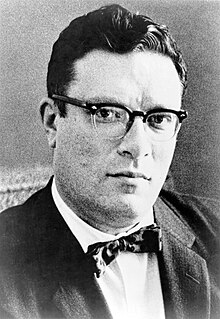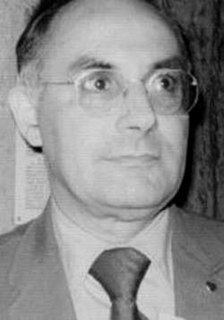Related Research Articles
The Futurians were a group of science fiction (SF) fans, many of whom became editors and writers as well. The Futurians were based in New York City and were a major force in the development of science fiction writing and science fiction fandom in the years 1937–1945.

I, Robot is a fixup novel of science fiction short stories or essays by American writer Isaac Asimov. The stories originally appeared in the American magazines Super Science Stories and Astounding Science Fiction between 1940 and 1950 and were then compiled into a book for stand-alone publication by Gnome Press in 1950, in an initial edition of 5,000 copies. The stories are woven together by a framing narrative in which the fictional Dr. Susan Calvin tells each story to a reporter in the 21st century. Although the stories can be read separately, they share a theme of the interaction of humans, robots, and morality, and when combined they tell a larger story of Asimov's fictional history of robotics.

Isaac Asimov was an American writer and professor of biochemistry at Boston University. He was known for his works of science fiction and popular science. Asimov was a prolific writer who wrote or edited more than 500 books and an estimated 90,000 letters and postcards.

John Wood Campbell Jr. was an American science fiction writer and editor. He was editor of Astounding Science Fiction from late 1937 until his death and was part of the Golden Age of Science Fiction. Campbell wrote super-science space opera under his own name and stories under his primary pseudonym, Don A. Stuart. Campbell also used the pen names Karl Van Kampen and Arthur McCann. His novella Who Goes There? was adapted as the films The Thing from Another World (1951), Horror Express (1972),The Thing (1982), and The Thing (2011).

The Three Laws of Robotics are a set of rules devised by the science fiction author Isaac Asimov. The rules were introduced in his 1942 short story "Runaround", although they had been foreshadowed in a few earlier stories. The Three Laws, quoted from the "Handbook of Robotics, 56th Edition, 2058 A.D.", are:
Thiotimoline is a fictitious chemical compound conceived by American biochemist and science fiction author Isaac Asimov. It was first described in a spoof scientific paper titled "The Endochronic Properties of Resublimated Thiotimoline" in 1948. The major peculiarity of the chemical is its "endochronicity": it starts dissolving before it makes contact with water.
A positronic brain is a fictional technological device, originally conceived by science fiction writer Isaac Asimov. It functions as a central processing unit (CPU) for robots, and, in some unspecified way, provides them with a form of consciousness recognizable to humans. When Asimov wrote his first robot stories in 1939 and 1940, the positron was a newly discovered particle, and so the buzz word "positronic" added a scientific connotation to the concept. Asimov's 1942 short story "Runaround" elaborates his fictional Three Laws of Robotics, which are ingrained in the positronic brains of nearly all of his robots.

Sam Moskowitz was an American writer, critic, and historian of science fiction.
"Robbie" is a science fiction short story by American writer Isaac Asimov. It was his first robot story and writing commenced on June 10, 1939. It was first published in the September 1940 issue Super Science Stories magazine as "Strange Playfellow", a title that was chosen by editor Frederik Pohl and described as "distasteful" by Asimov. A revised version of Robbie was reprinted under Asimov's original title in the collections I, Robot (1950), The Complete Robot (1982), and Robot Visions (1990). "Robbie" was the fourteenth story written by Asimov, and the ninth to be published. The story is also part of Asimov's Robot series, and was the first of Asimov's positronic robot stories to see publication.
See also: Isaac Asimov bibliography (categorical), Isaac Asimov bibliography (chronological)

"Nightfall" is a 1941 science fiction novelette by American writer Isaac Asimov about the coming of darkness to the people of a planet ordinarily illuminated by sunlight at all times. It was adapted into a novel with Robert Silverberg in 1990. The short story has been included in 48 anthologies, and has appeared in six collections of Asimov's stories. In 1968, the Science Fiction Writers of America voted "Nightfall" the best science fiction short story written prior to the 1965 establishment of the Nebula Awards, and included it in The Science Fiction Hall of Fame Volume One, 1929-1964.
George H. Scithers was an American science fiction fan, author and editor.
Hiram Gilmore "Harry" Bates III was an American science fiction editor and writer. His short story "Farewell to the Master" (1940) was the basis of the well-known science fiction movie The Day the Earth Stood Still (1951).
The Red Queen's Race is a science fiction short story by American writer Isaac Asimov; it uses the Red Queen's race from Lewis Carroll's Through the Looking-Glass as a metaphor for the final plot twist. The story also makes reference to Asimov's psychohistory. "The Red Queen's Race" was first published in the January 1949 issue of Astounding Science Fiction and reprinted in the 1972 collection The Early Asimov.

Before the Golden Age: A Science Fiction Anthology of the 1930s is an anthology of 25 science fiction stories from 1930s pulp magazines, edited by American science fiction writer Isaac Asimov. It also includes "Big Game", a short story written by Asimov in 1941 and never sold. The anthology was first published in April 1974, and won the 1975 Locus Award for Best reprint anthology.
"Fondly Fahrenheit" is a science fiction short story by American writer Alfred Bester, first published in the August 1954 issue of The Magazine of Fantasy & Science Fiction.
"Time Pussy" is an early science fiction short story by American writer Isaac Asimov.
"Super-Neutron" is a science fiction short story by American writer Isaac Asimov, originally published in the September 1941 issue of Astonishing Stories, and included in the 1972 collection The Early Asimov. Asimov originally intended the story to be the first in a series, but was unable to come up with any further story ideas.
"The Up-to-Date Sorcerer" is a science fiction short story by American writer Isaac Asimov. It was first published in the July 1958 issue of Magazine of Fantasy and Science Fiction and reprinted in the 1969 collection Nightfall and Other Stories.
Edward Page Mitchell (1852–1927) was an American editorial and short story writer for The Sun, a daily newspaper in New York City. He became that newspaper's editor in 1897, succeeding Charles Anderson Dana. Mitchell was recognized as a major figure in the early development of the science fiction genre. Mitchell wrote fiction about a man rendered invisible by scientific means before H.G. Wells's The Invisible Man, wrote about a time-travel machine before Wells's The Time Machine, wrote about faster-than-light travel in 1874, a thinking computer and a cyborg in 1879, and also wrote the earliest known stories about matter transmission or teleportation and a superior mutant. "Exchanging Their Souls" (1877) is one of the earliest fictional accounts of mind transfer. Mitchell retired in 1926, a year before dying of a cerebral hemorrhage.
References
- ↑ Waugh, Charles; Asimov, Isaac; Greenberg, Martin Harry, eds. (1981). Isaac Asimov Presents the Best Science Fiction of the 19th Century. Beaufort Books. p. 113. ISBN 9780825300387.
- ↑ "E.P. Mitchell Dies; 50 Years on the Sun". The New York Times . January 23, 1927. Retrieved 28 July 2020.
- 1 2 Moskowitz, Sam, ed. (1973). "Introduction". The Crystal Man: Landmark Science Fiction. Doubleday. ISBN 9780385031394.
- ↑ Fowler, David (May–June 2010). "Mathematics in Science Fiction, Mathematics as Science Fiction". World Literature Today . 84 (3): 48–52.
- ↑ Silverberg, Robert (2000). The Androids Are Coming: Philip K. Dick, Isaac Asimov, Alfred Bester, and More. Wildside Press. p. 10. ISBN 9781587152405.